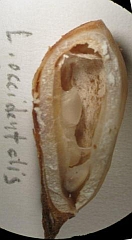Further evidences of Leptoglossus as causal agent of cone yield loss in Mediterranean stone pine [1]

Since its first detection in Europe in 1999, the invasive Western Conifer Seed Bug, Leptoglossus occidentalis, has been gaining increasing attention in the Mediterranean countries. This interest is mainly due to the putative impact of L. occidentalis on the edible seed of the Mediterranean stone pine, Pinus pinea L., a gourmet nut whose current retail price can exceed 70-100 €/kg. In most Mediterranean countries, pine nut production has collapsed since arrival of the bug. Several research groups, for instance at U. Lisbon and INIAV in Portugal, U. Valladolid and INIA in Spain, or INRA Orleans in France are studying the exotic pest and its damages caused in pine cones.
In this context, the PhD project developed by Ana Farina at University Lisbon about biology, prevalence and damages as forest pest of that notorious exotic seed bug in Mediterranean pines has gathered one more result, published recently in Forest Ecology and Management. [2] After having studied in a previous paper seed damages observed in mature seeds of Mediterranean stone pine Pinus pinea after feeding by Leptoglossus bugs reared in captivity (Agricultural and Forest Entomology [3]), the new paper presents answers whether this exotic bug might be responsible for the high damage observed in the last years on stone pine cones and seeds throughout the forests of south Europe, the Maghreb and Western Asia.
The experiment consisted in the use of mesh bags for covering some cones for insect exclusion, and other cones bagged with insects within (adults, nymphs). Results show that bag protection resulted in a significant decrease in the mortality of second-year conelets which dropped to 6% compared to 30% in exposed branches. Seed damage also decreased from 60% on exposed branches to 10% on protected ones. The presence of nymphs in the bags resulted in a mortality of second-year conelets 63% higher than in exclusion bags, whereas adults bagged in August had no more effect on conelet survival. In contrast, bags with adults presented the highest seed damage in ripening cones. Partial damage of the kernel endosperm can be considered as signature of L. occidentalis feeding since such damage was not observed in exclusion bags. Additionally, another type of seed damage, showing a wholly shrunken and dry embryo without remaining endosperm, and a reduction in the number of extractable seeds may also be attributed to this seed bug. Overall, seed damage per mature cone reached up to 12% in bags with two adult bugs enclosed for a month, i.e., twice the seed damage in protected cones.
These quite conclusive results coincide also with previous findings from the Spanish PROPINEA project [4] and underline once more the urgency to develop an integrated pest management for this insect that jeopardises the European pine nut value chain.
